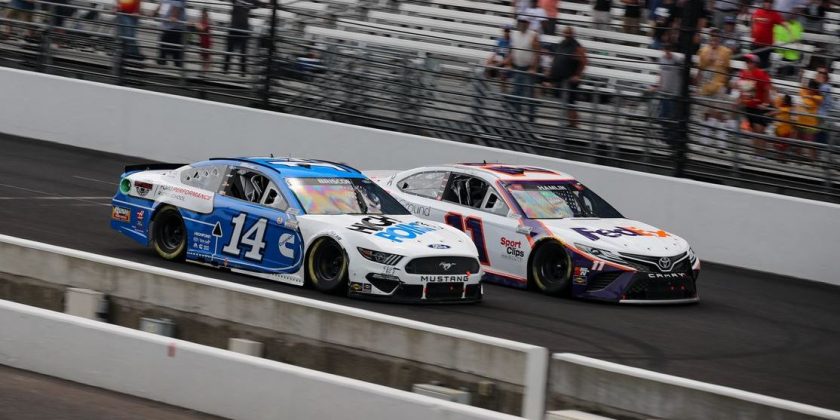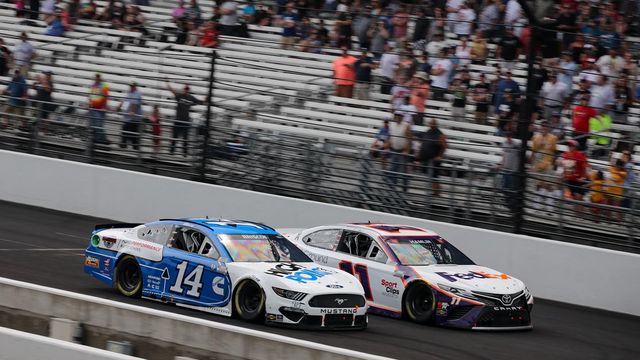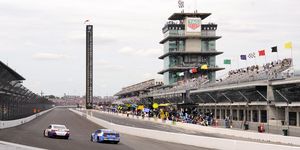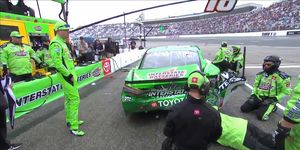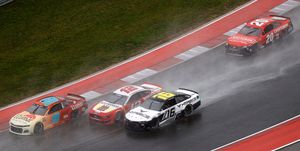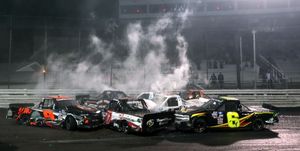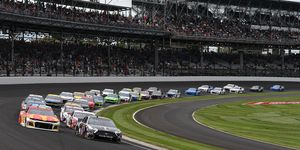2002 Formula 1 Ferrari staged finish
2005 Formula 1 six car race
2014 IndyCar standing start crash
2021 NASCAR Cup curb debacle
The Verizon 200 did not feature the pageantry and prestige of the Brickyard 400, but the finish certainly matched the two-decade old legacy of the Indianapolis Motor Speedway Road Course.
With 10 laps to go, the first Cup Series race at Indianapolis to not take place on the same layout at the Greatest Spectacle in Racing was fine, if not spectacular, but went completely off the rails by the finish.
The curbs in Turns 5 and 6 had taken a beating throughout the weekend and at several points even literally needed splitters removed from them.
The final six laps took an hour and 25 minutes to complete, featuring two green-white-checkers, several cars destroyed by the damaged curbs and leader Denny Hamlin getting dumped by Chase Briscoe after he had been penalized for ‘course cutting’ earlier in the lap.
This doesn’t even include a safety truck appearing on the track right at the end of qualifying as Corey Lajoie was still at speed.
“Did we go out a little early?”
A future @NASCAR_Trucks driver, perhaps? pic.twitter.com/zyKh0romvY
It was the latest race in a season full of schadenfreudethat has the Cup Series looking more like amateur hour every other week than a professional motorsports sanctioning body.
Sadly, there’s an audience for this, too.
After a competitive and thrilling return to racing from the Olympics last week, the Brickyard race was thematically similar to what transpired at New Hampshire when race control ignored their own turn spotters to start the race in the rain with several leaders crashing six laps in as a result.
The inaugural race at Circuit of the Americas was marred by several incidents in which NASCAR kept cars on track when a steady rain became a deluge. There is a difference between racing in wet and torrential conditions.
An hour of the race at Road America was contested under caution as NASCAR has yet to embrace local yellows.
Chase Elliott had led 44 of the first 57 laps in February at the Daytona Road Course and was driving away from second-place Christopher Bell when a caution was thrown for light rain on the southernmost portion of the track.
Because NASCAR has also yet to embrace a format where teams can choose when to pit under the threat of rain, like every other professional racing series that runs on road courses and under wet conditions, a caution was thrown and the end was decided by bedlam — the NASCAR way.
Not a single team opted to take rain tires during that caution at Daytona, the entire reason the yellow was thrown in the first place, by the way.
Don’t forget forcing the Truck Series to run at Bristol Dirt on a muddy track with a vehicle that still features a windshield, or NASCAR failing to call a caution for a driver (Trey Hutchens) stalled on the frontstretch until Johnny Sauter collided with him at full speed.
This is in addition to the eight races a year across all three divisions in which the entire point has evolved into deciding a victor based on who survives the various Big Ones.
I AM NASCAR
Some of this can be dismissed as the growing pains associated with adding five more road races, racing in the rain and even racing on dirt, but this has been very painful to watch for anyone who values sporting authenticity over mayhem.
Much of it is an obvious cultural flaw at the center of what major league stock car racing has become over the past decade.
Part of what stricken the Verizon 200 can be placed collectively at the feet of the drivers for driving straight over a construct designed to slow them down to make the apex as opposed to running through it.
But in the absence of any kind of penalty for doing so, why wouldn’t drivers continue to make the fastest time around the course when there was no expectation for a negative outcome?
For that matter, the last thing NASCAR as an industry needs is one more judgement call of why a driver cut track limits, which would surely devolve into the double yellow line superspeedway rule but on road courses.
The alternatives to curbs that drivers will choose to run over without a judgement-call penalty are more permanent structures like concrete or even a wall — both having very obvious drawbacks compared to the status quo, too.
The end of the race had huge implications on the regular season championship battle.
When Michael McDowell launched over the curb, it sent him into the path of Austin Dillon, who is in a battle with Tyler Reddick for what is currently the provisional playoff cutoff.
Then came what happened on the final run when Briscoe was pushed off course by Hamlin and AJ Allmendinger, incurring a penalty for cutting the course, as he reemerged on the track right behind Hamlin.
*By the way, for those wanting a penalty to Allmendinger or Hamlin, is that really the NASCAR you want, too?
There is still debate over when exactly the penalty message was relayed to Briscoe or if he even processed it while trying to secure his first win.
Briscoe made a move under Hamlin, but turned the leader, which allowed Allmendinger to take the lead and emerge victorious for the first time in seven years.
The implications were huge for Hamlin, who is still winless on the season, but also lost the regular season championship lead to Kyle Larson. That’s the difference between 15 and 10 bonus points applied to the start of every round of the playoffs.
Ask Kevin Harvick how decisive that could be.
All told, it was just an unfortunate turn of events for a race that was a fairly enjoyable jaunt up to that point, even if not matching the prestige of the Brickyard 400 but was more entertaining.
NASCAR, IndyCar and Roger Penske replaced a perhaps unrecoverable crown jewel with a once per year doubleheader featuring the two largest sanctioning bodies in North America.
Even if its not the Brickyard 400, that’s an intriguing ticket, and one that’s probably salvageable even after the final 10 laps of Sunday afternoon.
Track president Doug Boles said ticket sales were up 20 percent from last year, even if the television numbers were down from 4.3 million to 2.8 million viewers after the switch from July 4 to mid-August.
For future seasons, it would be refreshing to see some crossover with Jimmie Johnson returning to NASCAR for a one-off or the likes of Scott Dixon, Alexander Rossi and Josef Newgarden trying their hands at a Stock Car.
How about Allmendinger back in an IndyCar on a road course or Larson attempting to win races in over a dozen different disciplines?
That’s the next step of the new Brickyard weekend, which also includes a prestigious USAC Midget race on the Turn 3 IMS Dirt Track this week, featuring drivers from NASCAR and IndyCar, too.
This week hasn’t been a complete disaster, but like so much in motorsports, the finish often overrides everything that preceded it for better or worse.
Source: Read Full Article
